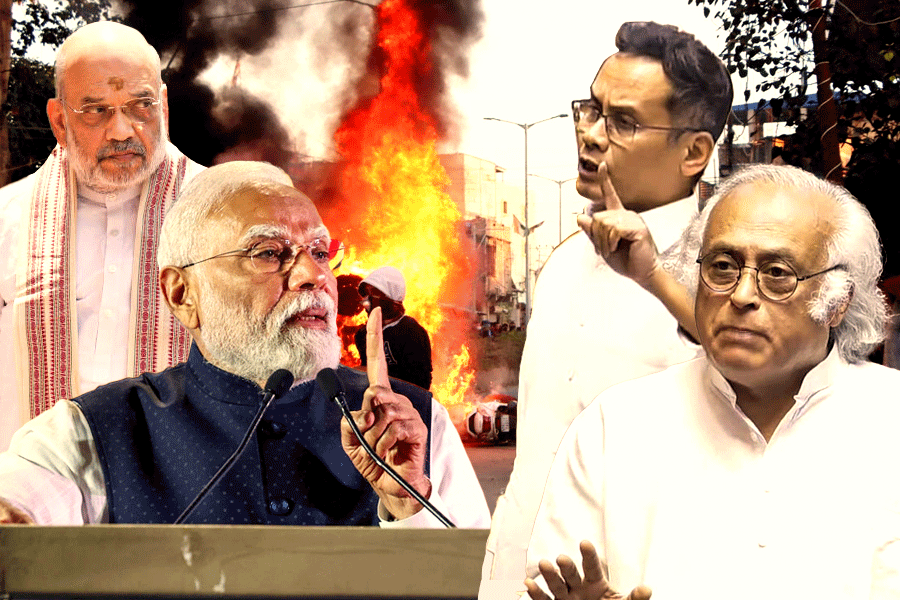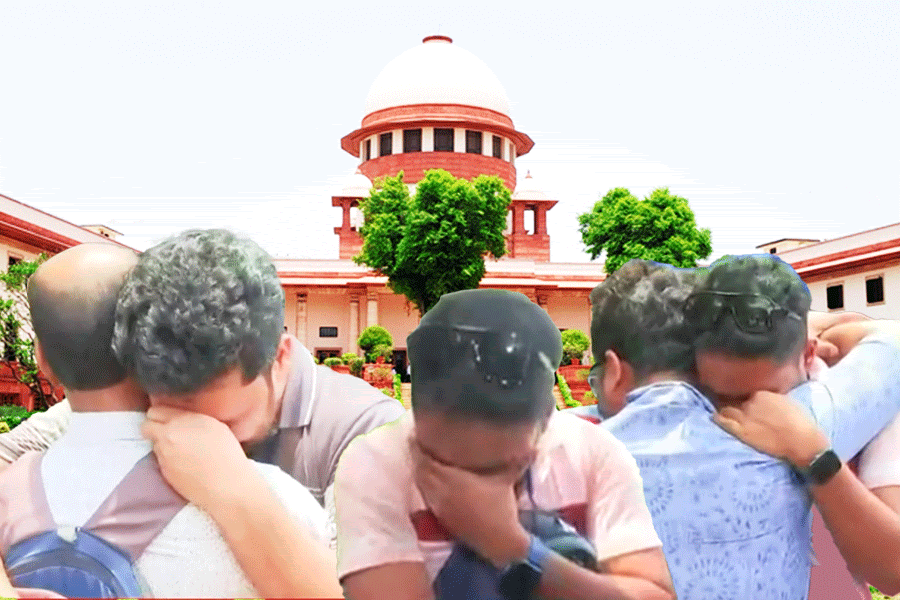|
|
'...I know such gestures can never suffice.' —Gayatri Chakravorty Spivak, 'Can the Subaltern Speak?'
Life, Art and Theory: the most natural, yet also the most difficult, threesome. Two events recently dovetailed in my life to afford a fleeting insight into this troubled coexistence. Together with some friends at work, I read, for the first time, Gayatri Chakravorty Spivak's 1988 essay, 'Can the Subaltern Speak?' It took us a few weeks to sink our teeth into the densities, now legendary, of Spivak's thinking and writing. Hard, but rewarding weeks, during which something else was happening at home, simultaneously.
My friend, Chandana, who had rented a room in our house to live and paint in, was finishing a portrait, in oil, of Shondhadi, the woman who has been coming in to work for us for the last twenty years. Most evenings, after we?d both finish work, Chandana would tell me, among other mundane things, of her deepening and difficult friendship with Shondhadi, a relationship she always described in terms of daily, domestic proximity ('nearness') and of 'love'. Yet, I felt, on Chandana's part, a strange diffidence about presuming to claim this increasing closeness for herself. An unbridgeable distance separated the two women, and Chandana was both pained by and in awe of this unbridgeability. But inevitably, there grew, across this distance, what she called a 'fullness' of mutual feeling and attempted empathy, which expressed itself, quite frenetically, through a series of watercolour studies of Shondhadi, and then, finally, this large painting.
Shondhadi is a tiny woman in her early forties. The elfin fragility of her person, her silent, cat-like movements about the house, her delicate little giggles, the neatness of her attire express not only a subtle, humane and finely comic intelligence, but also an equally cat-like and unmelodramatic ability to survive physical adversity. She had dropped out of 'Mother Teresa's school' to marry a travelling juggler and magician, who soon took to drugs. His addiction quickly got worse, and when Shondhadi was unable to give him children within a few years, he started to live with her sister, who bore him three sons and a daughter. By this time, he was beating up both women and taking away their money to buy drugs. During one of these fights, he shot at Shondhadi with a popgun, hitting her left eye. She lost the eye, and the bullet remains lodged inside the socket to this day, giving her frequent migraines. She also wears enormous glasses that heighten the gritty, unsentimental clownishness of her being, but also bring out its core of grimness. They make her look like a little girl who is refusing to take off her grandfather's spectacles. The two sisters now live together in a slum with the children. Their man appears from time to time to ask for money and food; he seems to have been put in his place. But Shondhadi refuses to leave her sister and the children to come and live with us day and night.
Shondhadi, then, is a woman 'doubly in shadow', one of the 'females of the urban subproletariat' in the third world who form the 'silent, silenced centre' of Spivak's essay. She is, by that definition, a subaltern. And — 'The subaltern cannot speak.' This is the terminal answer to what the essay's title asks. The disconcerting brevity of this answer is wilfully and perversely disproportionate to the long, hard road Spivak makes her readers travel in order to get to it. The unique problem of her essay is that the place of its subject is empty. This emptiness at once confronts, eludes, frustrates and resists, or is, simply and metaphysically, other than, different from and thus indifferent to, the consciousness and the conscience (the French conscience stands for both) forming the essayist's material and intellectual 'positionality', the conscience of the languages, methods, questions and assumptions by which she defines the subject of her essay and then attempts to grasp this subject as a form of knowledge that may be 'spoken' within the institutions and practices of such knowledge.
The heart of Spivak's essay, then, is a place of 'disappearance'. But instead of being a 'pristine nothingness', it is inhabited by 'something other than silence and non-existence'. As a place, it is inescapably fraught, gridded with 'Power, Desire, Interest', each trying to perform its own vanishing trick. Here an unspeaking otherness confronts another conscience to produce 'a violent shuttling' — between 'subject-constitution' and 'object-formation', between having a 'voice-consciousness' and being given one, between being able to speak and being spoken of or spoken for, between being silent and being silenced.
For Spivak, this is, crucially, a problem of 'representation'. And this is also the word that bridged the two events for me — reading Spivak's essay and watching Chandana paint Shondhadi. 'Are those who act and struggle mute, as opposed to those who act and speak?' the essay asks emphatically. And not making this distinction would mean running together the two senses of representation: 'representation as 'speaking for', as in politics, and representation as 're-presentation', as in art or philosophy.' The former is a proxy, while the latter is a portrait. These two senses, like the two senses of conscience, are 'related but irreducibly discontinuous' — the buried differences within words, which, when exhumed, open up rents and chasms in the apparently seamless textures of knowledge and power.
The peasants in Marx's Eighteenth Brumaire 'cannot represent themselves; they must be represented.' This was an epigraph to Said's Orientalism, and Spivak uses the same passage to warn against, as Marx does, the conflation of meanings — 'sleight of word' — by which it becomes easy to protect ourselves from the fact that to confront 'them' is not to represent them, but to learn to re-present ourselves.
Through the jagged rigour of Spivak's critique, there breaks out, every now and then, a personality (as much as a 'positionality') that 'shuttles' like its shadowy subject, but between existential awkwardness and theoretical flourish. This personality is informed with a flamboyantly irreverent professional confidence in being able to expose the 'meaningless pieties' of certain theoretical positions. Yet, this confidence is inseparable from a sense of the precariousness of its own position, the insufficiency of its own gestures, the inherent presumption, and violence, of wanting to grasp and know other consciousnesses, to repeatedly invoke shadows and silences, absences and disappearances, only to work over them a relentless swirl of languages, the clamour of one's own consciousness and conscience.
Gayatri and Chandana were both confronting a radical unbridgeability. All they could ultimately bring to this was the rigour and integrity, as well as the difficult, troubling pleasures, of their intellectual and artistic labour. But there is also a fundamental difference between their separate struggles with representation. What the subaltern cannot do is speak , and in Spivak's essay, quite literally so: 'the subject of exploitation cannot know and speak the text of female exploitation'. Yet it is precisely this textuality, with its injunction to speech, that the essayist must make her medium. For Spivak — critic, theorist, translator — there can be no deliverance from language, and therefore from its institutionalized production of meaning and value. Even when she turns from the rigours of theory to the succour of literature — to Mahasveta Devi, for instance — the Breast-Giver's bountiful mammaries cannot escape the rule of metaphor. There, too, in the 'effect of the real', the subaltern woman cannot, simply and bafflingly, be. When not History, she is Parable, 'the vehicle of a greater meaning'.
It is, therefore, in the necessary speechlessness of painting, its circumvention of language (though not of signification), that Chandana sought a different kind of resolution to the problem of representation. Her struggle was to find a silence that would do justice to another woman's silence, and then to let these two silences create a presence that would be proxy as well as portrait. The silence of her painting is more absolute than reticence — for reticence ('I know, but I choose not to speak') comes on its own high horse. But this is the silence of what the work cannot say, the assertion of an incapacity, a negative capability. 'We exist on different planes,' Chandana would say about herself and Shondhadi. But she kept trying to describe to me the feel of the thickness and softness of pigments as the brush pressed them, layer upon layer, over the stretched, but yielding canvass. That feel is, for her, the sensual, even sexual, correlative of what she called 'the merging of existences' in the making of a picture — of existences that otherwise must remain painfully and awfully apart.
Chandana's painting of Shondhadi is a frontal impasto portrait, done mainly in two of the most poisonous pigments used by painters — ultramarine blue and zinc oxide. She looks unflinchingly at the viewer with her good eye, dimly magnified by her huge, high-power glasses placed slightly askew on her face. The bad eye is like a single, shrivelled, but virulently yellow petal, shot with crimson, which also stains the corner of her forehead and streaks her hair. The picture stands in my room now — a gift from the artist when she moved out of our house. Shondhadi comes in to dust my room, and hardly ever notices the painting. But when I draw her attention to it sometimes, she gives a sharp little giggle and brings out that most dismissive of words in the Bengali language — 'Dhoorr!'












